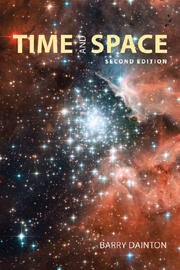Book contents
- Frontmatter
- Contents
- Preface to the second edition
- Preface to the first edition
- 1 Preliminaries
- 2 McTaggart on time's unreality
- 3 The Block universe
- 4 Asymmetries within time
- 5 Tensed time
- 6 Dynamic time
- 7 Time and consciousness
- 8 Time travel
- 9 Conceptions of void
- 10 Space: the classical debate
- 11 Absolute motion
- 12 Motion in spacetime
- 13 Curved space
- 14 Tangible space
- 15 Spatial anti-realism
- 16 Zeno and the continuum I
- 17 Zeno and the continuum II
- 18 Special relativity
- 19 Relativity and reality
- 20 General relativity
- 21 Spacetime metaphysics
- 22 Strings
- Notes
- Glossary
- Web resources
- Bibliography
- Index
1 - Preliminaries
- Frontmatter
- Contents
- Preface to the second edition
- Preface to the first edition
- 1 Preliminaries
- 2 McTaggart on time's unreality
- 3 The Block universe
- 4 Asymmetries within time
- 5 Tensed time
- 6 Dynamic time
- 7 Time and consciousness
- 8 Time travel
- 9 Conceptions of void
- 10 Space: the classical debate
- 11 Absolute motion
- 12 Motion in spacetime
- 13 Curved space
- 14 Tangible space
- 15 Spatial anti-realism
- 16 Zeno and the continuum I
- 17 Zeno and the continuum II
- 18 Special relativity
- 19 Relativity and reality
- 20 General relativity
- 21 Spacetime metaphysics
- 22 Strings
- Notes
- Glossary
- Web resources
- Bibliography
- Index
Summary
By way of setting the stage, this opening chapter introduces some of the most important metaphysical issues concerning time and space. Although many of the questions that can be asked about time can also be asked about space, and vice versa, time raises distinctive issues all of its own, and I will be devoting special attention to these. Some of the distinctive issues concerning space are discussed in Chapter 9.
Ontology: the existence of space and time
Do space and time exist? This is an obvious question, and one that is frequently addressed, but it can mean different things. Since philosophers raise the question of whether the physical world as a whole exists, it is not surprising that they ask the same question of space and time. However, the question “Do space and time exist?” is usually not asked in the context of a general scepticism. Those who pose this question generally assume that the world is roughly as it seems to be: objects are spatially extended (a planet is bigger than an ant), objects exist at different places and things happen at different times. So what is usually meant by the question is this: “Are space and time entities in their own right, over and above things such as stars, planets, atoms and people?”
The answer is not obvious, and for an obvious reason: both space and time are invisible.
Information
- Type
- Chapter
- Information
- Time and Space , pp. 1 - 12Publisher: Acumen PublishingPrint publication year: 2010
